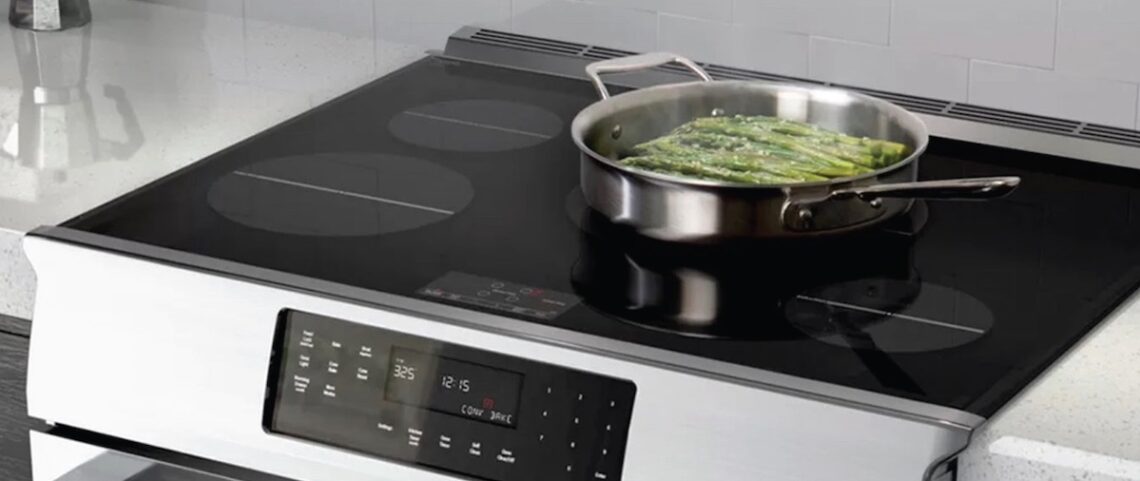Say Bye Bye to Gas in the Kitchen
Induction stoves allow consumers to happily leave behind fossil fuels in the kitchen. Plus, they cook food faster than other types of stoves, adjust heat instantaneously, offer precise temperature control, and are incredibly safe (they only work when a magnetic pan is placed on top of them, so no more accidentally leaving the burner on). Best of all, they are powered by clean electricity.
Like so many technologies in the electrified home of the future, induction stoves are exciting newcomers on the scene because they change the rules of the game. They eliminate one more gas industry argument for why we need methane (aka “natural” gas) in our lives at all. From a user’s perspective, induction stoves are amazing.
Before induction, the two choices facing cooking consumers were to use either gas burners or electric coils. In that scenario, gas seemingly had the upper hand. Its cozy blue flame hearkens back to something prehistoric in us, a cave person’s love of fire. Plus, gas flames can easily be turned up or down, quickly controlling cooking temperatures.
Next to this blue flame, electric resistance coils look less than ideal. They are inefficient, take forever to heat up and cool down, and make controlling temperatures a challenge.
Recently, it has become clear that there are some hidden (literally invisible) costs to gas that we weren’t always factored into our equations. An accumulating body of research shows that cooking with “natural” gas can release toxins like nitrogen oxides, particulate matter, and carbon dioxide, which exacerbate asthma and cardiovascular illness. Indoor pollution from gas negatively affects everyone, but even more so vulnerable populations like children and lower-income households, which tend to have more people and less ventilation in the home Plus, accumulating evidence shows that fracking, and the leaks in the distribution systems, mean that natural gas is similar to coal in terms of its climate-warming impact.
But, luckily, the whole equation has changed dramatically with induction stoves. They have all the good qualities of gas and none of its drawbacks and give us one more reason to switch our homes to be fully powered by clean electricity.
How Induction Works
Induction stoves, like microwaves, seemingly work by magic. The technology creates a magnetic field that directly heats iron in pans. The heat comes from within the pan itself rather than heating the space under the pan like a traditional stove,
Efficiency
Induction stoves are also more efficient than gas or electric coils. Energy transfer is around 84% compared to 74% with the older technologies. Cooking doesn’t account for a lot of energy use in the home, so the typical person probably won’t save much energy or money. Still, it’s nice to know that when you do cook, you’ll be doing it more efficiently. The critical thing to keep in mind about induction is that it debunks the gas industry argument that we need gas in our home for cooking.
Speed and control
Induction stovetops match and exceed gas in their ability to quickly change and control heat. There is no lag time with induction cooking like there is with electric resistance. Sauce bubbling too much? Lower your heat setting, and it’ll be instantly simmering more slowly. Induction offers excellent low heat settings that gas burners typically struggle with — no more burned rice on the bottom of the pan!
Induction also cooks far more quickly than other technologies and can boil six cups of water in two minutes. I’ve done demonstrations on my induction stove for family and friends to amaze them with just how quickly a watched pot boils on an induction stove. Your cooking style changes with this increased speed and responsivity. You no longer have to plan something else to do while you wait forever for pots and pans to arrive at the desired temperature.
Safety
Induction stoves are also the safest cooking technology available. The cooktop only heats magnetic pans and pots and turns off automatically after 10 seconds when it doesn’t detect a pan. No more accidentally bumping the stove and turning on burners (something that happens to my parents all the time).
Because induction cooking heats the pan rather than underneath the pan, the entire surface is much less hot and much less hazardous. There are strange YouTube videos of people frying bacon on induction stoves with their pan resting on top of dishtowels that are not harmed in the process.
This increased safety is a huge benefit for a family like mine with two toddlers. 300 children go to the emergency room every day with burns, and the reduced risk offered by induction stoves brings peace of mind.
Because the surface is literally a sheet of glass that does not get hot, this also means that your cooktop is more like an extension of your countertop. Unused “burners” can be used for preparation or serving.
Cost
The cost of induction stoves seems to be the greatest challenge to their full-scale adoption. The good news is that Consumer Reports has observed a decline in prices, with several models coming in at $1000 or less. This is still more than low-cost electric or gas stoves, but you’re paying for an improved cooking experience. Keep in mind you’ll also have to make sure your pots and pans are magnetic. Yale Appliances has some excellent buyer’s guides and reliable information compiled through thousands of induction range and cooktop installations.
Spread the word
In these times of fires, elections, and pandemics, a topic like “what stove you’re using” can seem trite and unimportant next to some of the more challenging issues we’re facing. But don’t be mislead by the humble nature of this subject — these stoves matter! The “Electrify Everything” strategy is the best way to solve our climate crisis quickly, and “cooking with gas” is one of the primary methods that the gas industry uses to convince consumers that we can’t live without it. The more people who use induction cooking and prove that argument wrong, the faster we can transition off fossil fuels.
Currently, only 1% of stoves in the US are induction — meaning we’ve got work to do to get the word out about the all-electric kitchen. Buy and experience one of these superior stoves yourself (my family did!), talk to your communities about induction cooking, and help make our kitchens safer, cleaner, and better.
And if we still haven’t convinced you, check out Electrify Now’s induction cooking webinar.
For more info: rmi.org/insight/gas-stoves-pollution-health
Joe Wachunas lives in Portland, Oregon, and works for the nonprofit Forth, which promotes electric transportation. He is also involved with Electrify Now because he believes that electrifying everything, from transportation to homes, is the quickest path to an equitable, clean energy future. And of course, Joe and his family live in an all-electric home and drive an EV.







